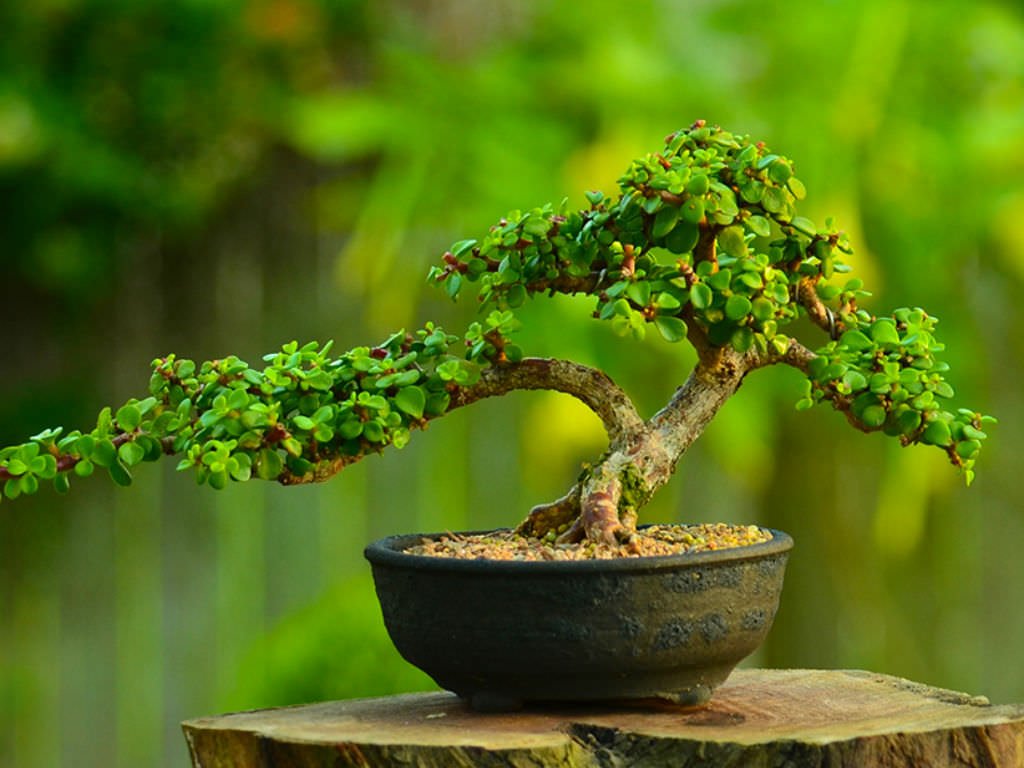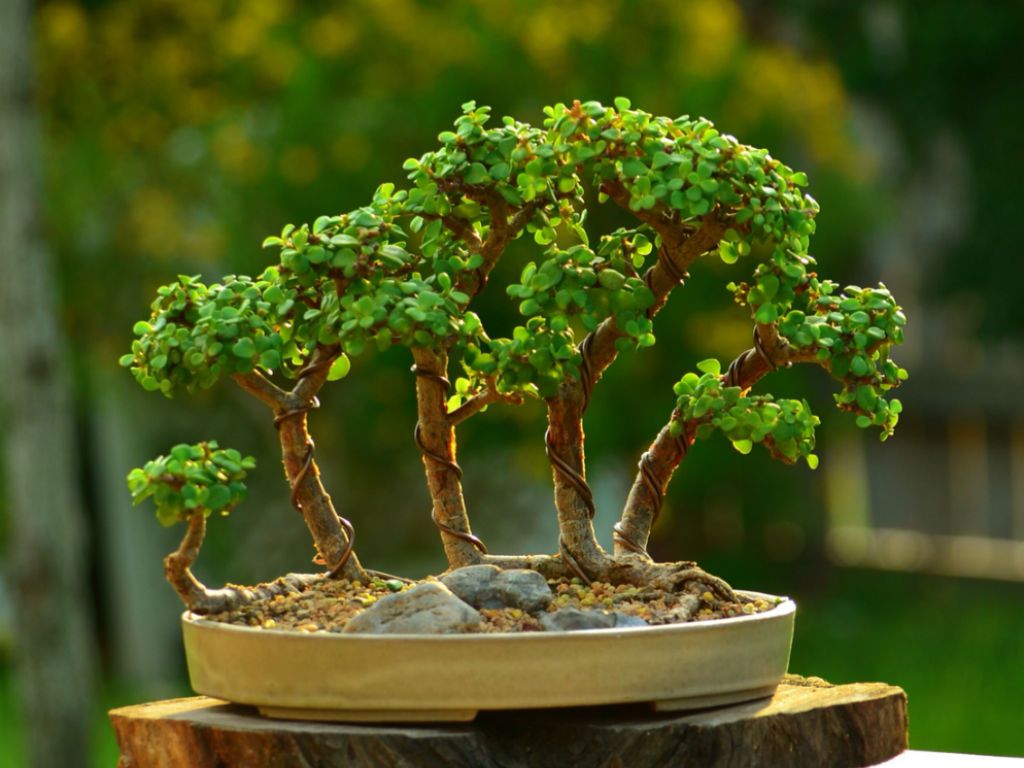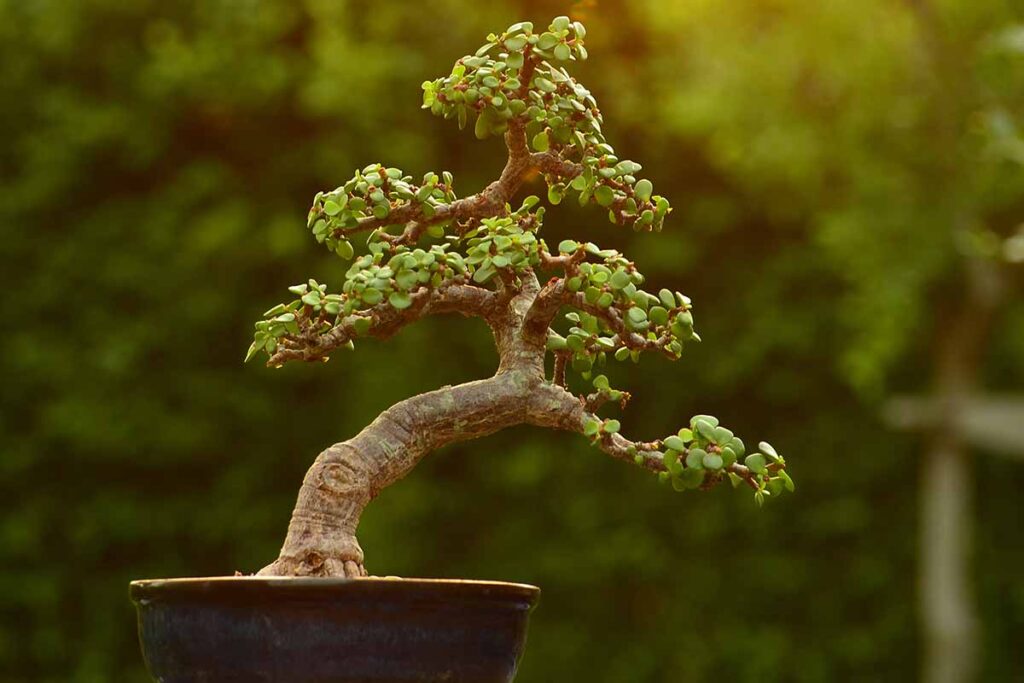The elephant bush bonsai tree or Portulacaria afra is a beautiful ornamental indoor plant. They serve as wild elephant food in its native land, that’s how it got the name.
Apart from being showy, they have a lot of other uses. The elephant bush is known as low-maintenance and by providing the right water, soil, and temperature requirements your plant can thrive for over fifty years.

Elephant bush bonsai Quick Facts
| Fact | Description |
| Scientific name | Portulacaria afra |
| Family | Didiereaceae |
| Native to | South Africa |
| Hight | Eight to fifteen feet |
| Lifespan | Over fifty years |
| Leaves | Fleshy, round, emerald-green |
| Flowers | Pink, star-shaped flower |
| Fruits | Berry-like, pink, single-seed dry fruits. |
| Cultivation | Popular as a bonsai tree |
| Symbolism | Good luck and prosperity |
| Uses | Ornamental plants for indoor, garden, and landscaping. It purifies indoor air. |
Elephant bush bonsai Care Guide
Portulacaria afra bonsai are relatively easy to care for and can tolerate various circumstances like other succulents. But they are slow grower plants and constant negligence will stun their growth even further. So it’s important to learn about their water, soil, temperature need, and right placement.
Elephant bush bonsai Watering
Elephant bonsai tree performs well with often watering sessions even though they are drought tolerant. They keep themselves hydrated in between watering periods through the sap they collect in their leaves.
These plants should be watered one time a week during summer and lessened amount to one time every ten to fourteen days during winter. Always aim for moist soil instead of saturated.
Rainwater or dechlorinated water is preferred to avoid any stressful situation. Tap water may contain minerals that stack up in the soil and prevents the roots from getting water and air.
You can use three methods to check the soil moisture; finger, chopstick, or moisture meter. Aim for the topmost part of the soil to dry out before watering.
Learn more about Watering a bonsai tree.
Elephant bush bonsai Temperature Tolerance
Common climate-controlled household temperature is ideal for elephant bush bonsai trees to thrive. Like other succulent species, elephant plants don’t crave humidity and are equipped to tolerate dry conditions. They love high temperatures, as high as 100 degrees Fahrenheit, but they are sensitive to frost and harsh cold weather.
If your intention is to grow the plant outside, use containers to grow them, as it would be easily moveable if the temperature goes below 25 degrees Fahrenheit.
Right Placement for Elephant bush bonsai
Bonsai elephant bush is not cold hardy. So if the colder zone of your living area can go less than 25-30 degrees Fahrenheit, you should use pots to grow them, so that they can easily be brought indoors. However, plant them in your garden where they can get partial sunlight for at least six hours a day. For indoor plants, place them near a sunny window, they also tend to stretch towards the sun, so keep them rotate from time to time.
Repotting Elephant bush bonsai
Portulacaria afra bonsai is one of the slowest-growing succulents, that’s why repotting only requires once every two to three years when it gets root bound. Re-pot in their growing season(spring or summer).
How To re-pot:
- Take a pot that is slightly larger than the current one and make sure it has draining holes.
- At the bottom of the pot put a shallow layer of potting medium or potting mix.
- Hold the base of the plant sideways and wiggle it gently. Don’t do the process by holding thin branches or leaves or you might break them. If the plant doesn’t come out use a root hook to loosen up the soil.
- You can use the hook or a chopstick to tease the root ball.
- Now place the plant in the new pot and put potting soil or growing medium at a length where the root ball would be one inch below the top surface of the pot.
Refrain from watering for a week to avoid shock, then resume your regular routine.
Best Soil for Elephant bush bonsai
The elephant bonsai tree doesn’t have a specific soil preference, an acidic to alkaline with a 5.6-7.8 pH kind of soil is what they love. But well-draining rich soil is a must.
To achieve that kind of soil you need to mix one part of perlite and two parts of cactus potting mix. You can add compost to the soil and you will get the perfect soil for your elephant bush.
How to Guides for Elephant bush bonsai
Now let’s talk about how you can prune, fertilize, and wire your bonsai in details.
How to Prune Elephant bush bonsai
Pruning is important in order to alter the shape or keep it in a compact size. Pruning is a viable option as Portulacaria afra is a slow-growing tree and will keep it’s shape for longer period. To prune;
- Snip the leaves according to your desired shape.
- Stop additional growth of a particular branch and prune them.
- Remove the dead leaves.
- Snip away dead branches.
- If there is any leaves or branch that are affected by fungal disease, remove and dispose of them.
Tips:
Avoid making concave cuts after the removal of the branch, it can scar the tree. It’s always safer to leave a small stub.
You don’t have to use cut paste after the cuttings, as elephant bushes naturally produce calluses to heal themselves. Using cut paste might backfire and attract fungus.
Sterilize the pruning tools to avoid infections.
Healthy cutting can be used to propagate more individuals.
If you desire a thicker trunk, use stones in the potting mix and if the weather permits feed them enough sunlight.
How to Wire an Elephant bush bonsai
Elephant bush bonsai barks are really soft and delicate and can hurt the tree if we go heavy-handed, so you have to be really careful while wiring them.
Not all elephant bush needs wiring, trees that have a good natural bend, can turn up in your desired shape just by trimming the leaves and barks. Trees that have a heavy growth without any bend can be wired. To wire elephant bush bonsai;
- Decide on the style of how you want to wire it first.
- Take an almost three-millimeter aluminum wire, and cut it at the length of the tree. If you use thinner wire, double up the wiring over one round.
- Put the wire into the soil, right at the base if you are wiring the trunk. Now start wrapping it around the trunk with a 45 degrees angle.
- After you are done with wrapping, take your time to bend it over a little according to the angle you want it to develop. The trunk is too delicate so don’t go overboard.
Tip:
You might face some leaves falling in the process, but don’t be scared, it’s normal.
Avoid watering for a week before wiring, if the trunk and branches are filled with water, it will be easier to crack while bending. Without water, branches will be more flexible and less likely to crack.
Learn more about How to Wire a Bonsai Tree Branch
How to Fertilize Elephant bush bonsai
Elephant bonsai bush doesn’t require fertilizer and is adapted to poor soil conditions. But to promote growth little fertilizer would be needed. As it promotes growth providing fertilizers during its growing season is ideal.
They can be fed once a month during spring and fall. Make sure the fertilizer is low in nitrogen. You can use diluted cactus fertilizer. If the leaves are getting scorched gradually, it’s a sign you are overfeeding them.
If your bonsai is kept in a cold room during winter, it doesn’t require feeding, but if it’s staying in a heated room, you can feed them once a month.
Check this detailed guide on How to Fertilize your Bonsai Trees the Correct Way
How to Grow an Elephant bush bonsai
To grow elephant bush bonsai in your home you can opt for two easy methods; growing from seeds and growing from cuttings.
How to Grow Elephant bush bonsai from Seed
- Prepare the potting mix. Cactus potting mix with pumice is an excellent potting mix for elephant bush. The soil mix should be rocky or shandy.
- Sprinkle the elephant bush seeds in the pot and make sure not to cover it with soil, as air and sunlight are needed for its sprouting.
- Water thoroughly to keep it moist and continue the process till it sprouts.
- Once the seeds overcome their germination phase, it’s time to transplant them into a new pot.
- Place the bonsai seedlings in a new soiled pot. Keep the plant moist.
Check this detailed guide on How to grow a bonsai tree from seed?
How to Grow Elephant bush bonsai from cutting
Three cutting methods can be use to grow portulacaria afra bonsai. They are; Stem cutting, leaf cutting, and root cutting. But root cutting has the possibility to create stress to the mother plant and leaf cutting takes a good amount of time to propagate. The stem cutting method is rather quick and easy to follow.
Stem cutting:
- Choose a healthy stem with fleshy leaves from the mother plant.
- Do a clean cut below a nod and let it dry before planting for a few days.
- Plant the cutting in cactus soil mix and moisten it. The soil should be moist but not wait as the plant are delicate in this phase, it’s prone to root rot faster than an established tree.
- It will take around one week to a month to formate roots, depending on the condition it is in.
Leaf-cutting:
- Take some leaves from the mother plant and let them dry for at least three days.
- Now plant the attached side in the potting mix and provide water.
- The roots will start to formate around the 3rd week, but the success rate is low.
For best results perform propagation in summer or spring.
Common Elephant bush bonsai Problems and Solutions / Diseases & Pests
Portulacaria afra bonsai are not susceptible to disease and pests, but a few issues can rise and most of them are caused by a damp environment.
Root rot
Root rot is the most common issue for succulent failure. Saturated soil conditions are breeding grounds for fungus and constant over-watering leads to many root issues and most notably root rot.
Solution:
Bringing back your plant from root rot is a gradual process. First, you need to lessen the frequency of watering. If it still doesn’t work, you need to re-pot the tree with better drainage soil and pot.
Botrytis
A fungal disease, caused by a damp environment and soil that has excess nitrogen. They format grey, velvety molds on the leaves.
Solution:
Remove the tissues that are affected and use fungicidal agents on the rest of the plant.
Spider mites
Spider mites are tiny and hard to locate. They are tiny white dots and are hard to notice to the naked eye. Search for the fine webbings underside of the leaves to locate them. These tiny terrors suck the sap off of the leaves and leave them dry.
Solution:
In water, add neem oil and spray on the leaves and infected areas.
Mealybugs
These tiny crawlers are hard to get rid of because of their waxy coatings.
Solution:
In a cotton swab, soak rubbing alcohol and apply it on the pests to break down the waxy texture and get rid of them.
Elephant bush bonsai Images






